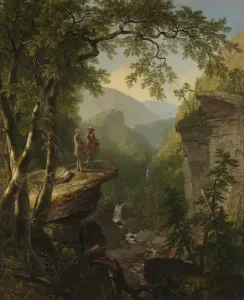The Hudson River School, a mid-19th-century American art movement, celebrated the sublime beauty of nature through luminous landscape paintings. These artists ventured into the wilderness armed with essential equipment that allowed them to capture the awe-inspiring views with precision.
Easel and Palette:

The Hudson River School painters relied on portable easels and palettes for plein air painting. Thomas Cole, a prominent figure in the movement, often used these tools while creating his masterpiece “The Oxbow.” The grandeur of the Connecticut River Valley is vividly captured in this iconic work. For your next plein air painting session, this French Box Easel is a great choice.
Sketching Materials:

Sketching was integral to the Hudson River School’s creative process. Frederic Edwin Church, another luminary, employed sketching materials like pencils and sketchbooks during his expeditions. Church’s “Heart of the Andes” showcases the meticulous sketches and detailed observations made during his travels in South America.
Before you put brush to canvas, this sketching set and quality paper will help get your ideas down.
Oil Paints and Brushes:

The artists of the Hudson River School favored oil paints for their ability to convey the subtleties of light and color. Albert Bierstadt, renowned for his sweeping landscapes, utilized a vivid palette and meticulous brushwork in his masterpiece “Among the Sierra Nevada, California,” capturing the majestic allure of the American West. The fluidity of Sennelier oil colors are a good choice for quick, expressive outdoor painting sessions. An artist quality paint, this set will definitely get you started on the right track.
Our Free Monthly Newsletter
Sign up and receive our free color Guide: Oil Painters Classic Palette. You’ll get early access to special offers and our interesting monthly digest straight to your inbox. Privacy PolicyField Telescope:

Hudson River School painters often used field telescopes to observe distant landscapes. Sanford Robinson Gifford, inspired by the sweeping vistas of the American wilderness, utilized a field telescope during his travels. Gifford’s “A Gorge in the Mountains (Kauterskill Clove)” exemplifies his keen attention to detail and appreciation for the sublime.
Travel Gear:

Given the remote locations explored by the Hudson River School artists, durable travel gear was crucial. Asher B. Durand, a key figure in the movement, painted “Kindred Spirits” outdoors, showcasing his skill in rendering the natural world. Durand’s equipment, adapted for the rigors of the wilderness, allowed him to bring to life the camaraderie between man and nature.
The Hudson River School, armed with their portable equipment, transformed the American landscape into a visual poetry that continues to captivate art enthusiasts. As we explore the tools of these masterful plein air painters, we gain insight into their intimate connection with nature and the enduring legacy they left on American art.
